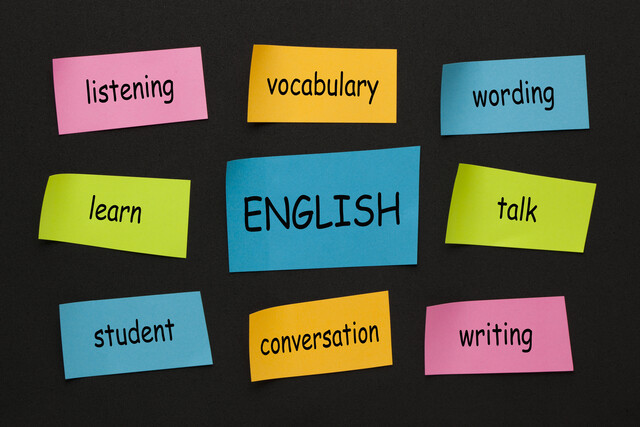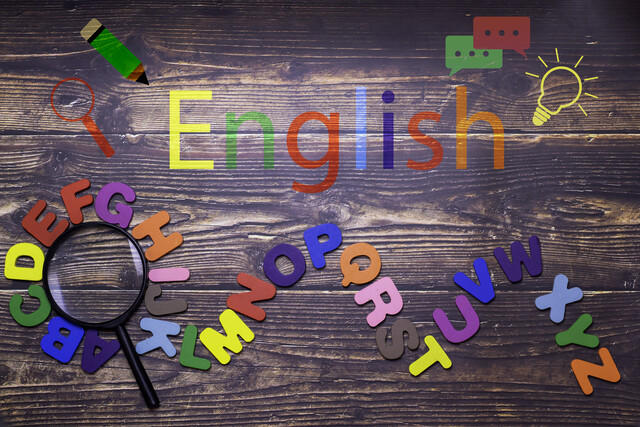Online Class: ESL Grammar Skills Level 4

no certificate
with CEU Certificate*
-
23Lessons
-
29Exams &
Assignments -
750Students
have taken this course -
9Hours
average time -
0.9CEUs
Course Description
Elevate Your English Proficiency with ESL Grammar Level 4
Unveiling the penultimate module in our renowned five-course ESL grammar series: ESL Grammar Level 4. This meticulously curated course acts as a pivotal bridge, effortlessly transitioning English learners from intermediate to the heights of upper-intermediate fluency. It stands as a testament to our commitment to help our students not just communicate, but to truly thrive and articulate with an unmatched sophistication in the English language.
Spread across 22 intricately designed units, this course boasts a streamlined, user-friendly approach. We believe that the mastery of a language doesn't lie in the complexity of content, but in its clarity and relevance. Each unit begins with a lucid presentation of the subject matter, crafted with utmost precision to ensure easy assimilation. This is closely followed by a range of lesson exercises, meticulously tailored to embed the concepts deeper into the learner's cognition.
To guarantee the application and retention of the newly acquired skills, the course features regular practice quizzes, four comprehensive examinations interspersed at strategic intervals, and a decisive final exam. This rigorous, yet engaging assessment method ensures that the learner is constantly aligned with the progression metrics, making the journey to the pinnacle of English mastery a rewarding experience.
Delving into the heart of the course, ESL Grammar Level 4 covers an impressive array of grammar topics. From the dynamism of gerunds and infinitives to the intricacies of future progressive; from mastering the perfect forms of the present to navigating the realms of present, past, and past progressive. We dive deep into the nuanced realms of relative clauses, conditionals 2 and 3, reported speech, and an array of minor yet crucial grammar aspects that often go overlooked in standard courses. This includes intricate details like distinctions between "both/either/neither", nuances in phrases like "a friend of mine", "by the time", "on my own/by myself", and the subtle might of "had better".
But our commitment to holistic learning doesn't stop at grammar alone. ESL Grammar Level 4 also includes lessons dedicated to refining your writing prowess. Discover the transformative power of conjunctive adverbs and unlock the secrets to crafting impeccable paragraph structures that captivate readers.
On culminating ESL Grammar Level 4, you don't just proceed to another level; you ascend to the zenith of advanced English language learning. Whether you're a first-time explorer of this content or a seasoned enthusiast aiming to polish your expertise, this course is more than a learning tool--it's an investment. An investment into a future of unparalleled English fluency, accuracy, and confidence. Dive in, and let us guide you through the labyrinth of English grammar to the pinnacle of linguistic excellence.
- Completely Online
- Self-Paced
- 6 Months to Complete
- 24/7 Availability
- Start Anytime
- PC & Mac Compatible
- Android & iOS Friendly
- Accredited CEUs

Course Lessons
Lesson 1. Mastering Either/Or and Neither/Nor
To determine course suitability, an entry test is recommended with instructions to consider lower levels if one scores 75% or less. The instructional focus is on 'both,' 'either,' and 'neither,' detailing their usage in sentence construction with appropriate verb agreements.Lesson 2. Understanding Possessive Phrasing in Friend Descriptions
Using 'my friend' signifies a direct possession, whereas 'a friend of mine' implies having multiple friends, with this person being one among them. The lesson emphasizes proper possessive forms depending on the subject and highlights usage errors to avoid, specifically 'a friend of me.'Lesson 3. Mastering the Present Perfect
Distinguishable from the simple past, the present perfect is used to discuss actions connected to the present, stressing unfinished periods or states. Commonly paired with adverbs like 'always' and 'never,' it highlights past experiences within an ongoing life narrative.Lesson 4. Understanding the Present Perfect Progressive: A Bridge Between Past and Present Actions
Combining present tense with past actions, the present perfect progressive focuses on activities' duration and progression over time. Its form highlights action continuity, using auxiliary elements and gerunds alongside participles.Lesson 5. Each vs. Every: Detailed Usage Guide
Both each and every serve to modify singular nouns, though each emphasizes separate units and every refers to collective frequency or general occurrences.Lesson 6. The Syntax of Subjects: Understanding Gerunds and Infinitives
Using gerunds or infinitives as subjects allows verbs to take on the role of nouns, focusing on the action or idea itself. Choosing between them often depends on the context or subtle differences in meaning.Lesson 7. Understanding Verb Combinations
The interplay between verbs involves gerunds, infinitives, or subjunctives, with the first verb guiding the form of the next. Essential verbs, such as 'admit' or 'avoid,' uniformly pair with gerunds to complete the action's expression.Lesson 8. Verbs and Infinitives
English grammar rules specify that certain leading verbs necessitate an infinitive form for any subsequent verbs, dictating the flow of sentence construction. Through examples like 'start to', 'fail to', and 'intend to', the structure of language is exemplified.Lesson 9. Understanding Object-Infinitive Dynamics in English
The structure of verb + object + infinitive is crucial for conveying directives and intentions in English. By analyzing verbs like 'motivate,' 'promise,' and 'command,' this lesson guides learners in effective communication.Lesson 10. Gerund or Infinitive: A Simple Guide
Verbs like 'start' or 'continue' exhibit the unique ability to pair with gerunds or infinitives without changing the core meaning. However, verbs such as 'remember' or 'try' exhibit distinct meanings based on this syntactical choice.Lesson 11. Understanding the Past Perfect: Unveiling Temporal Relationships
The past perfect tense expresses events that happened before another moment in the past, highlighting their sequence. It combines 'had' with past participles and relies on a context set by the simple or progressive past.Lesson 12. A Journey Into the Depths of the Past Perfect Progressive
Past perfect progressive connects past and earlier actions with 'had + been + gerund,' showcasing duration and ongoing nature over fact. For instance, 'They had been planning a trip to Jamaica' underscores the continuity of planning before plans changed.Lesson 13. Mastering 'By the Time'
The prepositional phrase 'by the time' is used to express temporal relationships between events, often employing perfect forms to do so effectively. Its use typically indicates that an event was completed before another started, emphasizing the duration or tardiness involved.Lesson 14. Mastering the Future Progressive Tense: Navigating Future Actions with Confidence
Express ongoing future actions with the future progressive by using 'will/be going to + be + gerund,' suitable for plans and predictions. It captures the continuity of actions expected to occur in future contexts.Lesson 15. Mastering Relative Clauses: A Deep Dive into Adjectival Functions
Building on prior knowledge of pronouns like who, which, and that, this lesson delves into where, when, whom, and whose, emphasizing their roles in adjective clauses. Comma placement varies based on the clause's necessity to the sentence.Lesson 16. Imaginary Conditionals: Creating Hypothetical Situations
With a past tense verb and 'would,' Conditional 2 encapsulates impossible present or future scenarios, diverging from the real context of Conditional 1. Its utility shines in hypothetical scenarios for advice or to express unique viewpoints.Lesson 17. The Past That Never Was: Conditional 3 Explained
Conditional 3 allows us to explore hypothetical scenarios in the past, imagining different outcomes for actions that never happened. It uses the if clause in past perfect and a past modal to illustrate how things could have been different.Lesson 18. Understanding Independence: On My Own and By Myself
'On my own' means doing something independently by choice, highlighting self-sufficiency and personal fulfillment. Conversely, 'by myself' can refer to being alone either incidentally or intentionally for introspective solitude.Lesson 19. Understanding the Power of 'Had Better' for Advice
'Had better' gives strong recommendations or prompts, functioning akin to a modal verb without conjugation across subjects or tenses. It consistently pairs with the base form of a verb for clarity and force.Lesson 20. Unlocking the Secrets of Reported Speech
Reported speech necessitates moving verbs to a past perspective while also adjusting pronouns to reflect the change in speaker. This transformation involves modifying verbs such as 'will' to 'would' and 'can' to 'could' to maintain coherence.Lesson 21. Sentence Connection Techniques using Conjunctive Adverbs
In written communication, conjunctive adverbs are pivotal for exhibiting logical relations such as addition and contrast between sentences. Positioned initially in a sentence, they help convey the intended meaning by delineating ideas smoothly.Lesson 22. Anatomy of a Paragraph
Paragraphs in English writing follow a three-part structure: the topic sentence introduces the idea, body sentences expand with increasing specificity, and the concluding sentence encapsulates the discussion. This structure ensures logical flow and clarity.Lesson 23. The Final Exam: Choose Wisely
As a course culmination, students must carefully select the best responses from available choices on the final exam. This endeavor not only tests their acquisition of knowledge but also their analytical decision-making skills.
Learning Outcomes
- Identify sentences where 'both of,' 'either of,' and 'neither of' must be used correctly to express inclusion or exclusion.
- Recognize the correct usage of 'both,' 'either,' and 'neither' in sentence construction with regard to verb agreement.
- Demonstrate understanding of possessive structures by correctly using 'my friend' and 'a friend of mine' in sentences
- Identify the implied difference in meaning between 'my friend' and 'a friend of mine' based on context usage
- Demonstrate understanding of using ever and never with present perfect in constructing and answering questions about past experiences.
- Identify the correct usage of the present perfect tense in sentences related to ongoing and completed actions.
- Analyze examples to differentiate between the present perfect progressive tense and other tenses by focusing on ongoing actions linking past and present.
- Identify and construct sentences using the present perfect progressive tense to demonstrate the link between past actions and current relevance.
- Demonstrate correct usage of 'each' and 'every' within various grammatical contexts, including their placement in relation to verbs and objects.
- Identify and differentiate between the interchangeable and unique uses of 'each' and 'every' in sentence construction.
- Differentiate between the use of gerunds and infinitives based on the type of action being expressed
- Recognize when to use gerunds and infinitives as subjects in sentences
- Recognize the rules governing verb combinations that require a gerund form for the second verb.
- Demonstrate mastery of lesson content at levels of 70% or higher.
Additional Course Information

- Document Your Lifelong Learning Achievements
- Earn an Official Certificate Documenting Course Hours and CEUs
- Verify Your Certificate with a Unique Serial Number Online
- View and Share Your Certificate Online or Download/Print as PDF
- Display Your Certificate on Your Resume and Promote Your Achievements Using Social Media

Choose Your Subscription Plan
No Certificate / No CEUs
This course only
| Includes certificate | X |
| Includes CEUs | X |
| Self-paced |

|
| Instructor support |

|
| Time to complete | 6 months |
| No. of courses | 1 course |
Certificate & CEUs
This course only
| Includes certificate |

|
| Includes CEUs |

|
| Self-paced |

|
| Instructor support |

|
| Time to complete | 6 months |
| No. of courses | 1 course |
Certificates & CEUs
Includes all 600+ courses
| Includes certificate |

|
| Includes CEUs |

|
| Self-paced |

|
| Instructor support |

|
| Time to complete | 12 Months |
| No. of courses | 600+ |
Certificates & CEUs
Includes all 600+ courses
| Includes certificate |

|
| Includes CEUs |

|
| Self-paced |

|
| Instructor support |

|
| Time to complete | 24 Months |
| No. of courses | 600+ |
Student Testimonials
- "It was a great course. In the level 3, before doing the lesson exam we had to do some practice exercises, which were very useful for understanding the lesson in a better way." -- Pablo B.
- "Very complicated stuff, but it was communicated effectively." -- Brian M.
- "The course was good. It was good to practice what we had studied earlier." -- Pragna P.
Related Courses
-
 72 hours
7.2 CEUs
Writing Help Course Bundle
+ More Info
72 hours
7.2 CEUs
Writing Help Course Bundle
+ More Info
-
 52 hours
5.2 CEUs
ESL Grammar Skills: Level 1-5 Course Bundle
+ More Info
52 hours
5.2 CEUs
ESL Grammar Skills: Level 1-5 Course Bundle
+ More Info
-
 17 hours
1.7 CEUs
ESL Basic Grammar and Writing
+ More Info
17 hours
1.7 CEUs
ESL Basic Grammar and Writing
+ More Info
-
 12 hours
1.2 CEUs
How to Write Case Studies
+ More Info
12 hours
1.2 CEUs
How to Write Case Studies
+ More Info
-
 6 hours
0.6 CEUs
ESL Basic Grammar
+ More Info
6 hours
0.6 CEUs
ESL Basic Grammar
+ More Info
-
 11 hours
1.1 CEUs
How to Write Effective Policies and Procedures
+ More Info
11 hours
1.1 CEUs
How to Write Effective Policies and Procedures
+ More Info
-
 7 hours
0.7 CEUs
Basic English Speaking Skills
+ More Info
7 hours
0.7 CEUs
Basic English Speaking Skills
+ More Info
-
 8 hours
0.8 CEUs
Teaching Grammar to ESL Students
+ More Info
8 hours
0.8 CEUs
Teaching Grammar to ESL Students
+ More Info
-
 14 hours
1.4 CEUs
Journalism 101
+ More Info
14 hours
1.4 CEUs
Journalism 101
+ More Info
-
 9 hours
0.9 CEUs
ESL Grammar Skills Level 5
+ More Info
9 hours
0.9 CEUs
ESL Grammar Skills Level 5
+ More Info
-
 11 hours
1.1 CEUs
ESL Basic Writing Skills
+ More Info
11 hours
1.1 CEUs
ESL Basic Writing Skills
+ More Info
-
 11 hours
1.1 CEUs
Writing Effective Emails in the Workplace
+ More Info
11 hours
1.1 CEUs
Writing Effective Emails in the Workplace
+ More Info




